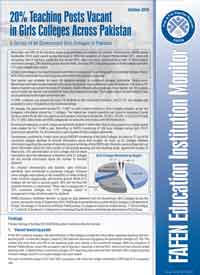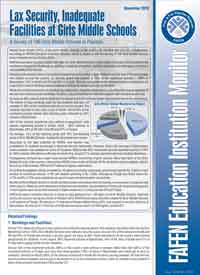A Survey of 94 Government Girls Colleges in Pakistan
ISLAMABAD, November 28, 2010: More than one-fifth of the teaching posts at government-run colleges for women, monitored by Free and Fair Election (FAFEN) during September 2010, were vacant across the country, according to FAFEN Education Institution Monitor released here Sunday.
FAFEN Governance Monitors visited 94 Government Girls Colleges across the country- 46 Girls Colleges in 28 districts of Punjab, 20 colleges in 16 districts of Khyber Pakhtunkhwa, 9 colleges in 9 districts of Balochistan, 17 Girls Colleges in 11 districts of Sindh and one college each in Islamabad Capital Territory (ICT) and Federally Administered Tribal Areas (FATA).
With the exception of Khyber Pakhtunkhwa (KP), where the occupancy rate of teachers’ vacancies was almost 93%, other provinces lacked teaching staff. In Balochistan’s monitored colleges, 29% teaching posts were not filled. Similarly, 28% of teaching posts in Sindh colleges and 24% in Punjab colleges were vacant. A higher percentage of non-teaching posts were filled in comparison to teaching posts in monitored colleges. Nearly 92% of the sanctioned non-teaching posts were filled in the monitored colleges.
One teacher was available for every 45 students enrolled in monitored colleges nationwide. Region-wise, Balochistan had better student-teacher ratio where one teacher was available for every 34 students, followed by KP, where a teacher was present for every 37 students. Sindh followed with an average of one teacher per 39 students and in Punjab, one teacher was available for every 56 students on average. Punjab’s lower student-lecturer ratio can be attributed to the higher enrollment rate. In FATA, a teacher was present for every 10 students in the monitored institution, and in ICT, one teacher was available for every 18 students in the monitored college.
On average, the government spends Rs. 17,467 on each student enrolled in Girls Colleges annually, as per the budgetary information shared by 17 colleges. The highest per-student spending was found in Islamabad Capital Territory where Rs 28,483 were spent on each student, followed by Sindh (Rs. 23,341), KP (Rs. 17,523) and Punjab (Rs. 12, 620). Balochistan and FATA colleges did not share this information with FAFEN Monitors.
Government spending on each college-going female student is lower than what is being spent on a college-going male student by Rs. 1,348 a year. According to FAFEN monitoring of 106 boys colleges during April 2010, the government spends Rs. 18, 815 annually on each student of boys colleges nationwide.
Transparency surfaced as a major issue during FAFEN’s monitoring of the Girls Colleges. As many as 77 out of 94 monitored colleges declined to provide information about their budget. As many as 21 colleges withheld information regarding the number of students present on the day of the FAFEN visit. Similarly, some colleges did not share information about the total number of sanctioned teaching and non-teaching posts, against the number of filled posts. The administration of nine colleges did not share information about the attendance of teachers while 21 colleges did not provide information about the number of enrolled students.
For physical infrastructure and facilities, bare minimum standards were maintained in monitored colleges. However, some colleges were lacking in the availability of clean drinking water, furniture, playgrounds, and security guards. While 31% colleges did not have a security guard, 28% did not have the required furniture in classrooms. There was no playground in 22% monitored colleges and 17% colleges lacked in the arrangement of clean drinking water for students.
To download complete report, click here



